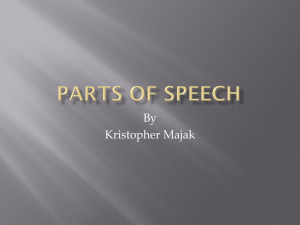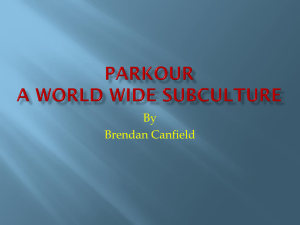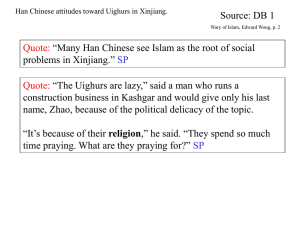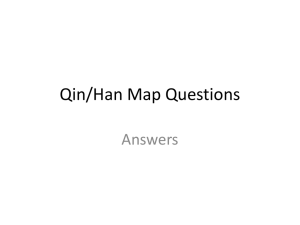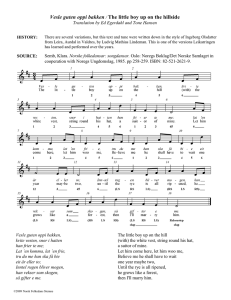New sport called parkour helps ease ethnic tensions in Chinese
advertisement
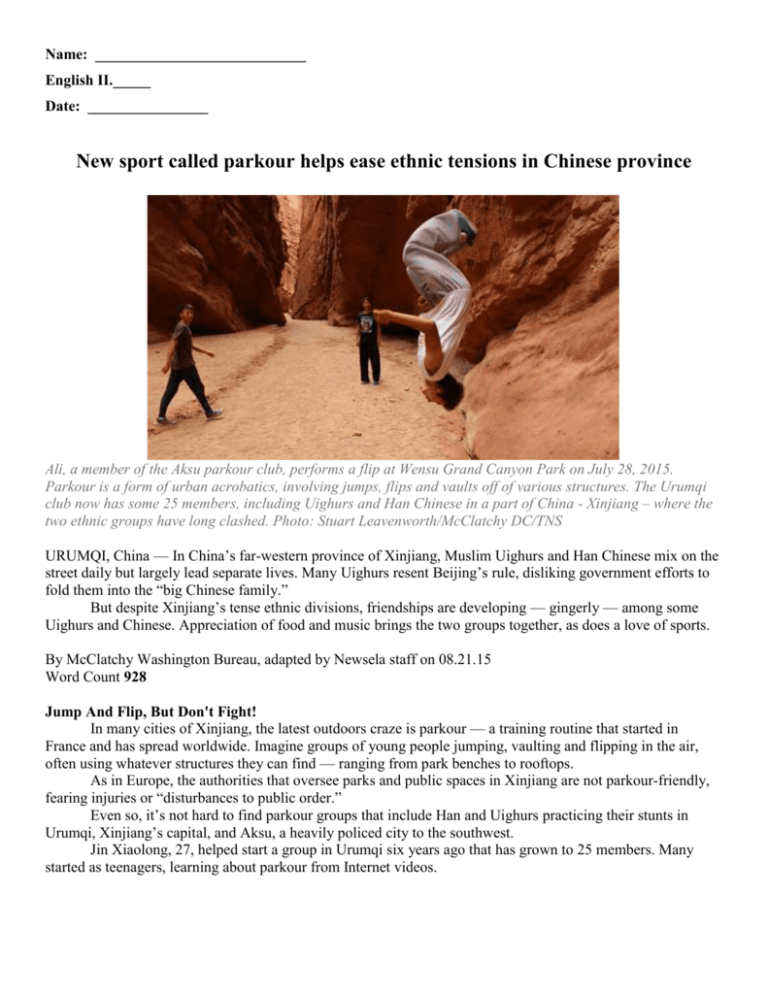
Name: ____________________________ English II._____ Date: ________________ New sport called parkour helps ease ethnic tensions in Chinese province Ali, a member of the Aksu parkour club, performs a flip at Wensu Grand Canyon Park on July 28, 2015. Parkour is a form of urban acrobatics, involving jumps, flips and vaults off of various structures. The Urumqi club now has some 25 members, including Uighurs and Han Chinese in a part of China - Xinjiang – where the two ethnic groups have long clashed. Photo: Stuart Leavenworth/McClatchy DC/TNS URUMQI, China — In China’s far-western province of Xinjiang, Muslim Uighurs and Han Chinese mix on the street daily but largely lead separate lives. Many Uighurs resent Beijing’s rule, disliking government efforts to fold them into the “big Chinese family.” But despite Xinjiang’s tense ethnic divisions, friendships are developing — gingerly — among some Uighurs and Chinese. Appreciation of food and music brings the two groups together, as does a love of sports. By McClatchy Washington Bureau, adapted by Newsela staff on 08.21.15 Word Count 928 Jump And Flip, But Don't Fight! In many cities of Xinjiang, the latest outdoors craze is parkour — a training routine that started in France and has spread worldwide. Imagine groups of young people jumping, vaulting and flipping in the air, often using whatever structures they can find — ranging from park benches to rooftops. As in Europe, the authorities that oversee parks and public spaces in Xinjiang are not parkour-friendly, fearing injuries or “disturbances to public order.” Even so, it’s not hard to find parkour groups that include Han and Uighurs practicing their stunts in Urumqi, Xinjiang’s capital, and Aksu, a heavily policed city to the southwest. Jin Xiaolong, 27, helped start a group in Urumqi six years ago that has grown to 25 members. Many started as teenagers, learning about parkour from Internet videos. "This Is Very Cool" “This kind of sport is not only popular in Xinjiang, it’s also pretty popular across China,” said Jin, taking a rest from one of his workouts on a Sunday afternoon. “As soon as guys see it, they like it because it is passionate and vigorous. When they see it, they feel like, ‘Wow. This is very cool.'" Government officials and scholars closely watch the mindset of Xinjiang’s younger generation. Uighur men in their teens and 20s are thought to have taken part in several recent attacks against Chinese police and civilians. Some studies have concluded that younger Uighurs are more more likely to turn against the government than previous generations. Part of the reason is that they are so wired to events abroad, such as the “Arab Spring” uprising. Discrimination Versus Friendship But unrest in Xinjiang is not limited to Uighurs influenced by extremist ideology. Some are angry at Chinese restrictions on their dress and appearance — such as men wearing beards. Others laugh at propaganda posters, visible all over Xinjiang, that portray the Chinese Communist Party as a unifying force for ethnic harmony. Before he was arrested and sent to prison last year by a Chinese court, the Uighur intellectual Ilham Tohti wrote about employment discrimination in Xinjiang. He said the practice has left tens of thousands of young Uighurs unemployed and sometimes lured into a life of petty crime. “On the one hand, the Uighurs’ social problems lead to increasing dissatisfaction and distrust of the government and of Han people,” Tohti wrote in 2011. “On the other, discriminatory ideas against the Uighur people among members of Han society — especially in the interior of China — grow deeper.” "We Are Like Brothers" Which makes the cross-cultural friendships that grow up around parkour all the more interesting. Similar to martial arts, parkour emphasizes self-discipline and humility, though Jin said his group in Urumqi does not take that to extremes. Members of the parkour club joke with each other like young competitors anywhere. “This sport parkour brought us together from all over, regardless of ethnicity,” said Wang Hui, 20, as he put his arms around two teammates — Parhat and Su Dan. “So we don’t see one another as being from other ethnicities. We are very close. We are like brothers — good friends.” The group’s members acknowledge it is unusual in Xinjiang for Han and Uighurs to develop close ties and scholars of the region agree. Passionate About A Sport Timothy Grose, a U.S. scholar, has made several trips to Xinjiang to interview residents. He said Uighurs and Han may forge individual friendships, but they continue to cling to the cultural stereotypes they were brought up with. “Outside their personal relationships, several of my Uighur friends complain about ‘the Han,’” said Grose, an assistant professor who specializes in Xinjiang ethnic relations. In Aksu, a city where armored vehicles patrol the streets, the local parkour club is led by Pulat, an 18year-old Uighur who is finishing high school. He and his brother, a videographer, helped put Aksu on the map by producing some slick parkour videos, some set in the scenic Wensu Grand Canyon Park outside of the city. “I can’t tell you how passionate we are about this sport,” said Pulat, during a trip out to the Wensu canyon with several of his friends. Once there, they took turns practicing flips and vaults off various ledges, as Pulat shot video. Not Completely Surprising Pulat said that the park officials love the publicity they receive from the club’s videos. Officials once called his school see if he could be excused from class to finish an ongoing video project, Pulat said. Tang Qi, a Han college student, said it is not completely surprising that Uighurs and Han would bond over a sport such as parkour. “When you pick up a hobby with friends when you are young, you are less susceptible to propaganda,” said Tang. Whether such friendships in Xinjiang survive is hard to know and both Han and Uighurs face family pressures not to socialize closely with each other. Marriage between the two groups remains taboo, said Grose, who specializes in ethnic identity in Xinjiang and other parts of China. “Uighurs and Han regularly carve out their own social spaces. Some of these social spaces overlap and are inclusive,” he said. “Others are exclusive.” Quiz 1 What is a central idea of the section "Jump And Flip, But Don't Fight!"? (A) Parkour is a method of training that has spread from France to the rest of the world. (B) Public authorities in Xinjiang see parkour as a potentially dangerous disturbance. (C) Parkour is becoming more popular in Xinjiang although authorities do not approve. (D) Many parkour participants learned about the practice through videos on the Internet. 2 Which sentence from the article is LEAST important to include in a summary of the article? (A) Tang Qi, a Han college student, said it is not completely surprising that Uighurs and Han would bond over a sport such as parkour. (B) He said Uighurs and Han may forge individual friendships, but they continue to cling to the cultural stereotypes they were brought up with. (C) The group’s members acknowledge it is unusual in Xinjiang for Han and Uighurs to develop close ties and scholars of the region agree. (D) Whether such friendships in Xinjiang survive is hard to know and both Han and Uighurs face family pressures not to socialize closely with each other. 3 How does the section "Discrimination Versus Friendship" contribute to the article? (A) It defines the ideological views of extremist Uighurs in China and the government's response. (B) It describes the personal experiences of Uighurs who cannot find employment in China. (C) It explains why the Chinese government does not approve of Uighurs' participation in activities like parkour. (E) It provides insight into the conflicted relationship between Uighurs and the Chinese government. 4 Read the sentence from the section "Jump And Flip, But Don't Fight!" As in Europe, the authorities that oversee parks and public spaces in Xinjiang are not parkour-friendly, fearing injuries or “disturbances to public order.” Which paragraph in the section "Not Completely Surprising" makes a statement in contradiction to the sentence? Choosing Between Affect and Effect Here are some rules and examples that will help you understand the difference between the words affect and effect. Although there are a few exceptions, you will be right more than 90% of the time if you remember to use affect as a verb as shown in these first three examples. Affect (ALWAYS A VERB) 1. To have an influence on EXAMPLE: The price of gasoline affects the economy. 2. To respond to the emotions of; touch or move. EXAMPLE: The news of his wife’s affair did not affect the husband. 3. To attack or infect, as a disease EXAMPLE: High cholesterol can affect the heart. In contrast, effect is nearly always used as a noun. Some people help themselves remember this by thinking of the special effects in some of their favorite films. See how in these examples effect is used as a noun. Effect (NEARLY ALWAYS A NOUN) 1. Something brought about by a cause EXAMPLE: The effect of his missing class was getting assigned to Saturday detention. 2. The power to produce an outcome or achieve a result; influence EXAMPLE: The effects of the Tylenol should be felt within twenty minutes. 3. A scientific law, hypothesis, or phenomenon EXAMPLE: The Greenhouse Effect is the rise in temperature that the Earth experiences because certain gases in the atmosphere trap energy from the sun. PRACTICE EXERCISE A. In the four sentences below, fill in the blank spaces with either affect or effect. If you are using one of them as a verb you may need to change its tense. 1. The D.A.R.E. program had a great ____________ on the student population. 2. Smoking cigarettes can _________ the lungs and possibly be the cause of death. 3. My best friend was greatly __________ by his mother’s recent death. 4. Drowsiness can be a side _________ of cold medicine. B. In the four sentences below, circle the correct word to complete the sentence. 1. The senior class prank had a major affect/effect on the entire student body. 2. Studying for quizzes and exams can affect/effect a student’s final grades. 3. Carpooling can affect/effect the environment in a positive manner. 4. Some vitamins can have an instant affect/effect on the immune system. C. Make up two sentences on your own, using affect in the first sentence and effect in the second sentence. 1. __________________________________________________________________________________ 2. __________________________________________________________________________________ Choosing Between Fewer and Less The key to knowing when to use fewer and when to use less is having a firm understanding of mass nouns and count nouns. Mass nouns are called non-count nouns because they are not readily countable as with such words as music, justice, time, sunbathing, and virtue. Count nouns name things that you can count as with such words as cars, books, shoes, friends. The rules of grammar state that we are to use less with mass or non-count nouns as in, “Once school starts, there is less time for sunbathing.” We are to use fewer with count nouns as in “Math classes require fewer books than do English classes.” Speakers often change mass nouns into count nouns either by providing a container (which can be counted) or by referring to the item with a different word. For example, ice cream is a mass noun, but ice cream cones can be counted. Money is a mass noun, but if we change and say dollars, then it can be counted. With the following examples of mass nouns using less, see if you can provide a way to turn them into count nouns so that fewer can be used. Less milk, but fewer __________________ Less honey, but fewer __________________ Less food, but fewer ___________________ Less clothing, but fewer __________________ Less oil, but fewer _______________________ Less paint, but fewer _______________________ Speakers of English can use more with either a count noun or a mass noun. This is probably one of the reasons that people have a hard time remembering that we need to distinguish between fewer and less. Another reason is that advertisers and package designers prefer to use short words so they can make the type bigger. Because of this, we sometimes see labels on prepared food and drink reading “LESS CALORIES!” In formal, written English the correct message would be “FEWER CALORIES!” because calories are something that can be counted. PRACTICE EXERCISE Part I: With these sentences, write either less or fewer in the blank spaces. 1. She takes ______________care of her siblings than is good for them. 2. There are _______________ murals in Denver than there are in San Francisco. 3. Radio disc jockeys play _____________ rock music than they used to. 4. Radio disc jockeys play _____________ rap songs than they used to. 5. Water has ________________ calories than soda has. 6. We saw _________ cars by the Grand Canyon than we see everyday around Phoenix. 7. The students have ____________ minutes to eat lunch now that the class periods are extended. 8. The student have _____________ time to eat lunch now that the class periods are extended. 9. Does America have __________ culture than Mexico? 10. Suzie has ___________ responsibilities now that her Aunt has come to help. Part II: Now make up two sentences of your own using fewer and two using less. Fewer: 1.__________________________________________________________________________________ 2.__________________________________________________________________________________ Less: 1. __________________________________________________________________________________ 2. __________________________________________________________________________________ LIE vs. LAY I would not be a liar if I told you that People lay their puppies down. Puppies lie on people. People lie on beds. It is bad to lie to a friend. It is also bad to get laid off (that is, set aside by your employer.) Lie means, “to repose.” It is intransitive and never takes an object, as in, I lie down to sleep. A different lie that is spelled and pronounced the same means, “to fabricate or mislead” someone through speech as in, He lied to me. or He told a lie. Lay means, “to put.” It is transitive and always takes an object as in, I lay my baby down to sleep. Here is a chart showing how these three confusing words are conjugated: Present Tense Telling an Untruth lie Transitive Verb lay Intransitive Verb lie Past Tense lied laid lay Past Participle have lied have laid have lain Present Participle is lying is laying is lying PRACTICE EXERCISE: Part I: In the following sentences, write in the correct form of these three confusing verbs. It will be one of the verbs shown in the chart. 1.Would you please ____________ the book on the desk and help me? 2. Don’t __________ to me; I promise not to be mad if only you will tell the truth. 3. Why don’t you ____________ down and take a nap before we go? 4. After ___________down the concrete, the workers began to dig another trench. 5. The mother told her son to ______________ still. 6. She has ___________in bed for four months now. 7. As I ____________ me down to sleep, I pray the Lord my soul to keep. 8. Someone __________ the treasures there hundreds of years ago. 9. They ____________ out $4,000 for their daughter's wedding reception. 10. Mark Harris has written a book with an ambiguous title, “__________ in Bed.” Part II: Now write one sentence of your own using the past tense of these three verbs: 1. __________________________________________________________________________________ 2. __________________________________________________________________________________ 3. __________________________________________________________________________________ Who, Whom, and Whose Who, whom, and whose are pronouns and therefore have specific cases that dictate where each can be used in a sentence. When trying to determine which pronoun to use, you must first determine if the pronoun is acting as a subject, an object, or an indicator of possession. When trying to decide what role a pronoun is playing, it is often helpful to think of other pronouns that could be substituted for the one in question. Who is a pronoun in the subjective case and must be used only as the subject of a verb. Who went to the movies last weekend? We use “Who” because the pronoun acts as the subject for the verb “went.” In this instance, who could be replaced by another pronoun in the subjective case, such as he, she, we, I, you, etc. For example, you could respond to this question by saying, “We went to the movies last weekend.” Who does not have to be the subject of the entire sentence, though, and is often the subject of a clause instead. The woman who owns the shop works in the morning. In this sentence, the subject is woman and the verb going along with this subject is works. The clause who owns the shop is inserted between the subject and the verb. In this clause, who serves as a subject for the verb owns and is therefore correctly placed in the subjective case. Whom is a pronoun in the objective case and must be used as the object of verbs or prepositions. For whom are you looking? We use “whom” because the pronoun acts as the object of the preposition “For.” In this instance, whom could be replaced by another pronoun in the objective case, such as him, her, us, me, you, etc. For example, you could respond to this question by saying, “I am looking for him.” Whose is a pronoun in the possessive case and must be used to indicate possession of an object. Whose book is this? We use “Whose” because the pronoun is indicating that the book belongs to someone. As in the other instances, whose could be replaced by another pronoun in the possessive case, such as his, her, our, my, your, etc. For example, you could respond to this question by saying, “This is her book.” PRACTICE EXERCISES Complete the following sentences with who, whom, or whose. 1. The man ___________ has two dogs usually goes to the park during the evening. 2. My mother, for __________ I baked a cake, had her birthday party yesterday. 3. My sister, __________ son is two, works at the hospital. 4. My friend, with __________ I live, wants a cat. 5. The people __________ live there have a boat. 6. That is the lady __________ sculpture I bought. 7. My grandma, __________ is an excellent cook, made dinner. 8. To __________ should I address the letter? 9. The students __________ read the book gave a nice presentation. 10. __________ jacket is on the floor? Now try to write three sentences, using a different pronoun in each. 1. __________________________________________________________________________________ 2. __________________________________________________________________________________ 3. __________________________________________________________________________________ Independent Reading Bookmark 5 Form three questions that begin with the following prompts and answer them. What is? Where/when is? Which is? What did? Where/when did? Which did? What can? Where/when can? Which can? Question 1: _______________________________________________________________________________ _________________________________________________________________________________________ Answer 1: ________________________________________________________________________________ __________________________________________________________________________________________ __________________________________________________________________________________________ __________________________________________________________________________________________ __________________________________________________________________________________________ __________________________________________________________________________________________ Question 2: _______________________________________________________________________________ _________________________________________________________________________________________ Answer 2: ________________________________________________________________________________ __________________________________________________________________________________________ __________________________________________________________________________________________ __________________________________________________________________________________________ __________________________________________________________________________________________ __________________________________________________________________________________________ Question 3: _______________________________________________________________________________ _________________________________________________________________________________________ Answer 3: ________________________________________________________________________________ __________________________________________________________________________________________ __________________________________________________________________________________________ __________________________________________________________________________________________ __________________________________________________________________________________________ __________________________________________________________________________________________ Short Answer Response “The Jacket” Identify the tone of the passage. Support your answer [Grab your reader’s attention with a great quote from the document or use this space to emphasize a key point. To place this text box anywhere on the page, just drag it.]


